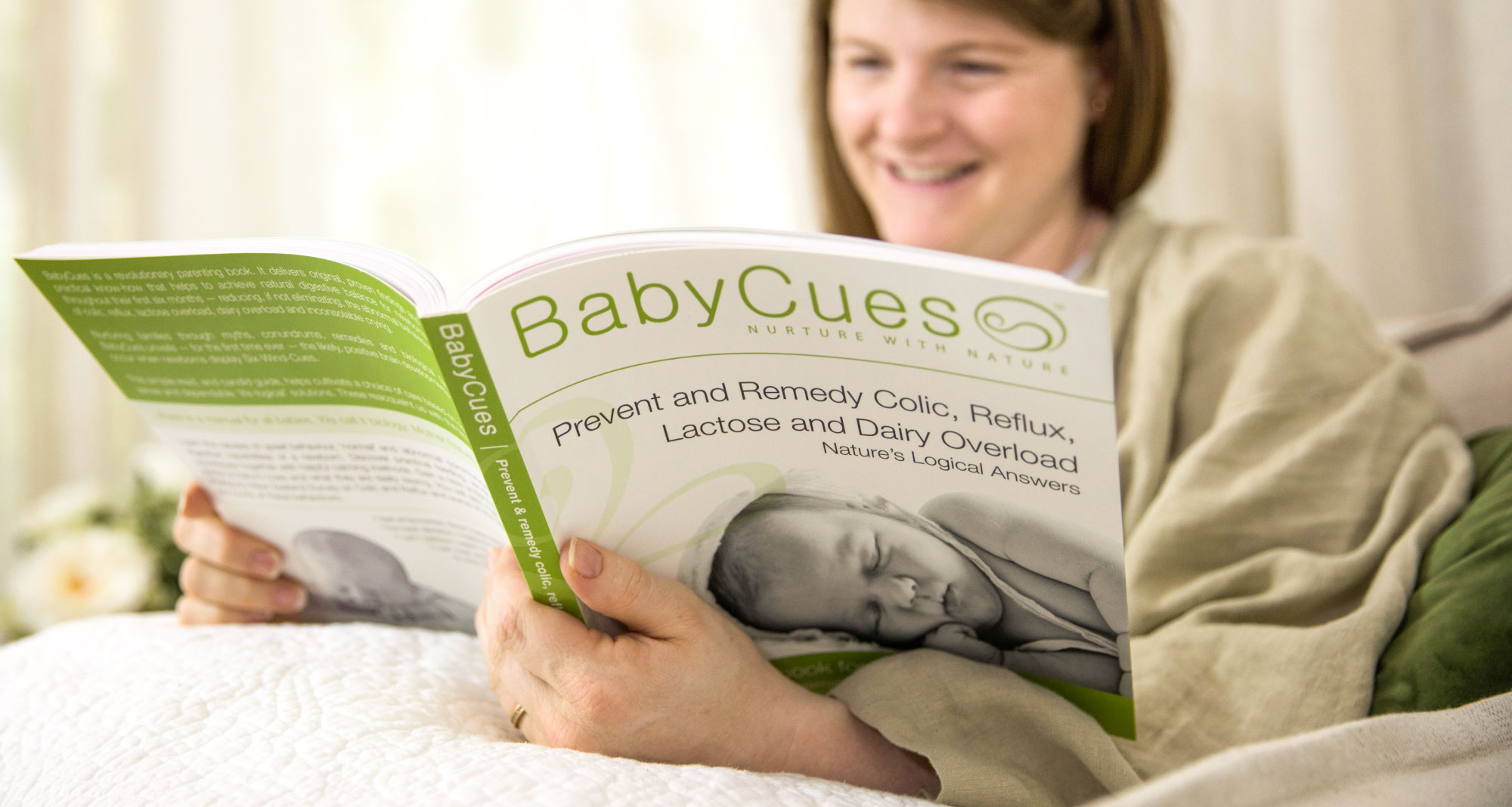Cue AND digestive led feeding

Firstly, let’s start with the obvious - “demand feeding” or what is also called “responsive feeding” is the best way to feed a child, because I’m sure we would all agree it’s of course ideal to feed our newborn’s responsively, which according to the Merriam-Webster Dictionary means reacting appropriately or sympathetically. So, what needs redefining right? These labels totally encapsulate a respectful way to nurture feeding.
But one must then surely ask, and make sure, that the taught practices behind the labels actually answer the child’s holistic demand appropriately and sympathetically, yes? Stands to logic. For example, we can’t simply just label a cue as a hunger cue, and not acknowledge that it can also mean a number of other natural demands, so may require another natural response – one that considers and attunes to the whole child. So, what does that mean?
Well, for me it means, we need to deliver care that is based on “cue-led connection” whilst having "digestive understanding". Now some might say, “Yes. That’s what is currently being taught under the labels of “demand or responsive feeding.” But is it really? Or do we need to redefine our delivery and have a fresh, new label as we evolve our feeding practices for the benefit of newborn health? Let’s delve into it.
Newborn hunger cues…
Presently, most parents in the Western world will hear that the following cues are hunger cues. However, as many of you will instinctively already know, witnessing these “hunger cues” can be confusing at times, especially at those times when you see the cues after having just fed your baby and all your instincts say, “But you can’t be hungry, I just fed you, and I know you have feed well.” So, let's look at the other reasons your may exhibit these widely taught “hunger cues” for another reason…
Sucking on hands – while this may be a hunger cue, sucking on hands can also be about development and self-soothing. In fact, twelve weeks after conception, your unborn baby is coordinated enough to suck his or her thumb, and a study undertaken at Durham University in 2013 found that babies fetuses were able to predict, rather than react to, their own hand movements towards their mouths as they entered the later stages of gestation compared to earlier in a pregnancy, in preparedness for social interaction, self-soothing and feeding.1 So postnatally your baby could simply be continuing this instinctual knowing and learning as they learn to self-sooth when they feel digestive movement and discomfort in their bigger space. Or perhaps they are actually teething to, which can occur anytime after birth.
Lip smacking – this is highly misinterpreted as a hunger cue, but lip smacking is more-often than not accompanied by a baby poking out their tongue, which in fact means your baby is showing you one of their Six-Wind-Cues. This cue communicates that they have trapped air sitting high in the stomach or esophagus that needs to be released through burping. If you feed at this time, generally baby will struggle to latch, or if they do, they will reflux quite soon after their feed because the pocket of air that wasn’t released before feeding, will push the milk out on its release. Otherwise, for older babies, lip smacking can be about their early exploration of actions creating sound.
Keep reading for more Wind-Cues after Three Top Burping Tips advert...
3 Top Burping Tips
These three top tips may just surprise you for many parents around the world are taught to do these burping practices, but they actually hinder the release of trapped air in the stomach.
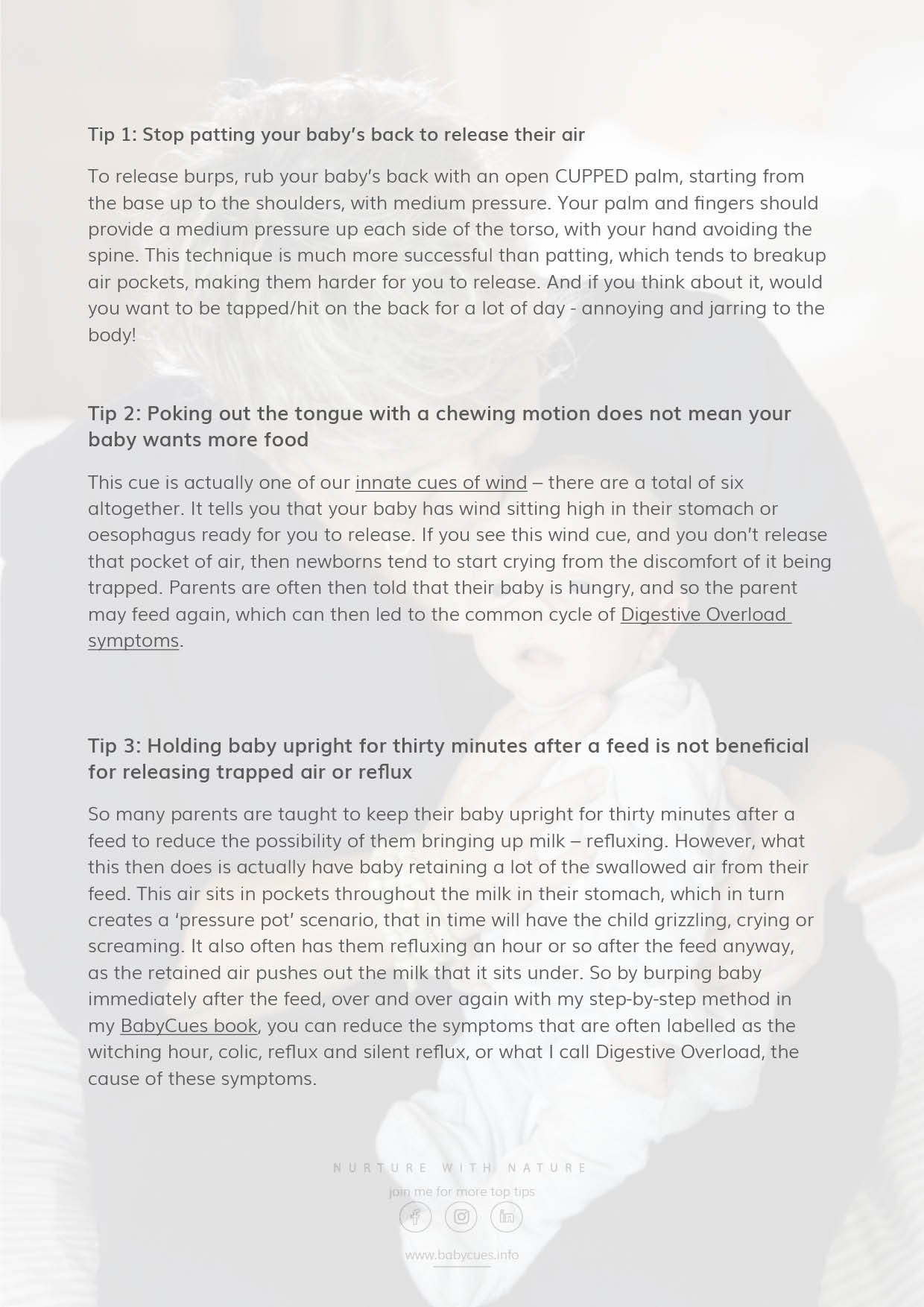
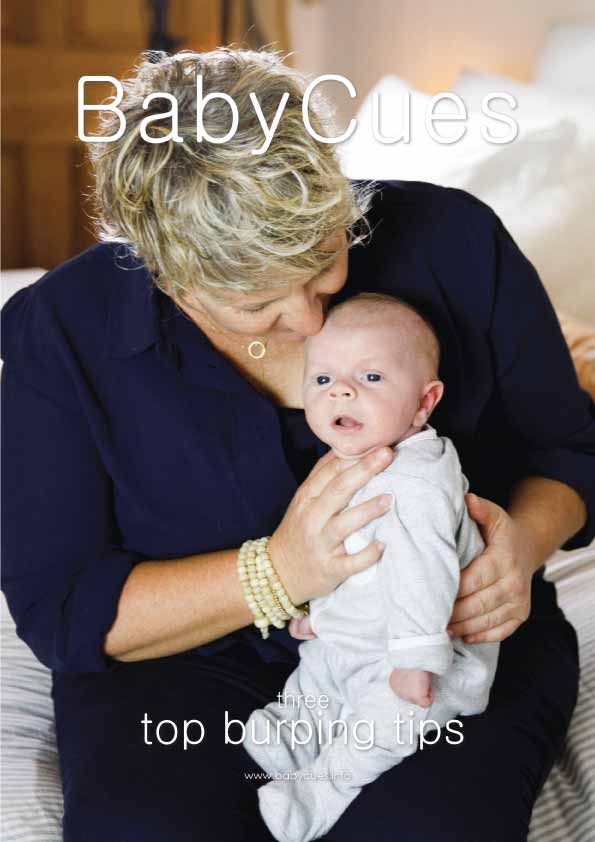
- Stimulating air release
- Recognise a wind-cue
- Beneficial positioning


WHAT'S INSIDE
- Stimulating air release
- Recognise a wind-cue
- Beneficial positioning
Opening and closing the mouth – well of course there are many things that can have a baby doing this like crying, having air ready to be released, teething, interaction with parents or environment, of something may have simply touched their cheek or mouth which has set off their root reflex, which has them opening their mouth...
Rooting to suck – this is one of the most misinterpreted hunger cues, because if babies are rooting, they are looking to suck. Let’s repeat that because it is an important sentence; rooting is about sucking. It is us that then attaches the thinking that sucking is always about hunger. Yes, baby may root to suck when they are hungry, but they also do this when they feel digestive movement (whether it’s painful or not) and to swallow essential salivary enzymes for digestion.
Move their eyes around – hmmm. Anyone else think that this is ambiguous? Do I really have to say that newborns move their eyes around for many reasons? However, what I do need to let you know is that if your baby is largely happy and starring off into space while moving their eyes around, then this is actually another Wind-Cue that I have discovered and named the Windy Stare. The Windy Stare also lets you know that your baby has a burp, or burps, that are ready to be released and you can do this by using the numerous positions and calming techniques in my ten-step-method of burping, called Nature’s Wind Sequence, which you can learn more about in my Burping and Gas Masterclass
Wriggling and getting restless – this cue can also happen when baby is feeling natural or heightened levels of nutrients, air or waste moving through their tummy, intestines or bowel. It might also happen when baby is tired.
Crying – many parents are told that they should ideally feed their baby before they get to the crying stage. But this belief has parents presuming that crying means they have missed the window of opportunity and now their baby is highly hungry. This can lead to doubt, anxiety and a lack of confidence in the parent’s ability to read cues. Besides, while a very hungry baby might cry from hunger, usually they cry because they feel pain in the digestive system. Because a baby that has natural levels of hunger and is relatively comfortable with digestive function, tends to grizzle, whimper, and moan when hungry. Not cry or even scream. These are more pain cues, which would tend to only happen in regard to hunger if a child has been left too long between feeds, or there is an issue with transference when breastfed so they are indeed hungry and may have consumed excess air, or they are not being bottle fed to their natural feeding volumes for their age.
Keep reading for more Wind-Cues after Feeding Volumes advert...
Feed baby to physiological capacities
This BabyCues Guide outlines the amounts to feed a newborn and infant, up to one year of age, when nurturing with BabyCues Bio-logical Feeding methods, which means feeding baby every three-and-a-half to four hours, thus working alongside our children's natural digestive function.
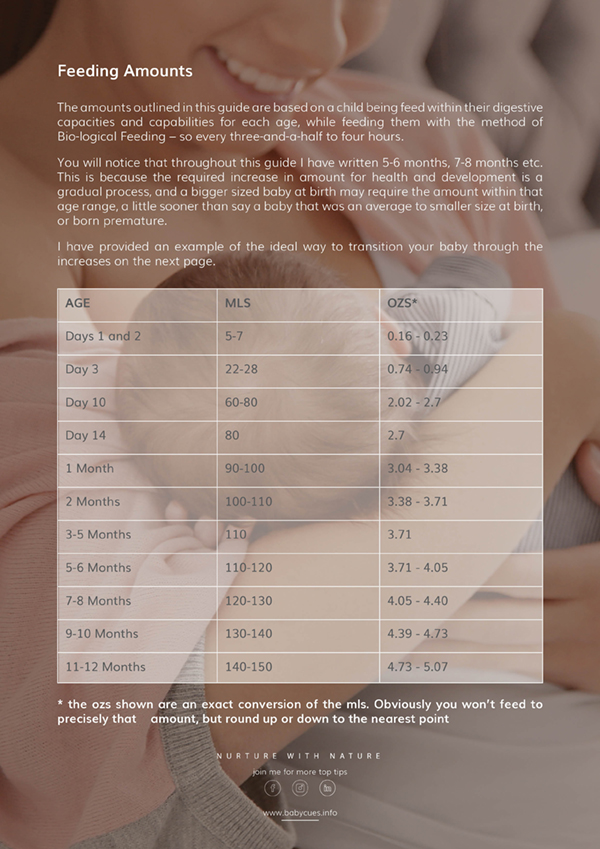
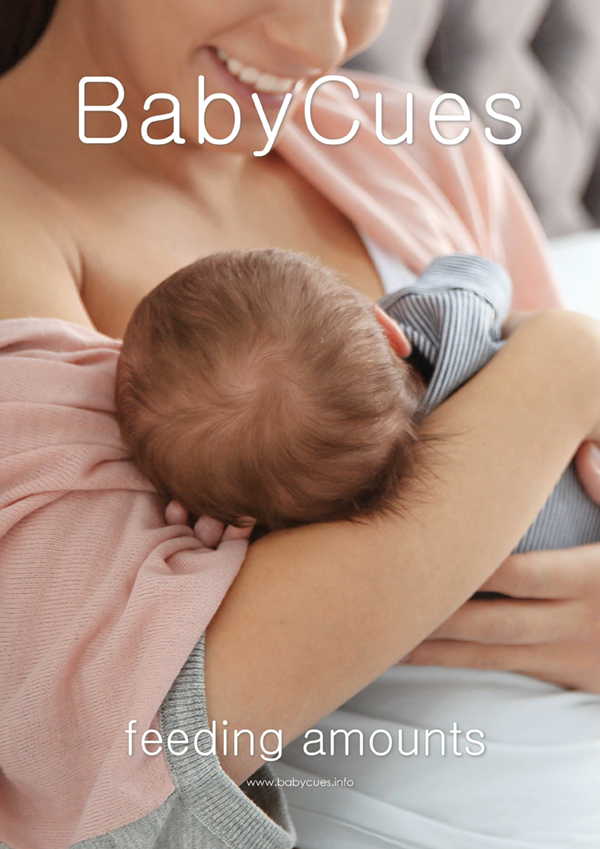
- foster digestive health
- feed to natural capacities
- Reduce Digestive Overload Symptoms


nurture naturally
- foster digestive health
- feed to natural capacities
- Reduce Digestive Overload Symptoms
So, hopefully you can see how these cues are actually quite confusing. How can a parent seriously decipher if their baby is communicating hunger, when only using “cue-led communication”, right? And how can one then make sure we are not creating Digestive Overload symptoms (the real cause of colic, reflux, silent reflux, lactose and dairy overload, the witching hour and some cases of mis-diagnosis cow's milk protein intolerance) and excess weight gains from overfeeding? Or even impacts on weight gain through underfeeding. Well, this is why it is absolutely necessary for us to integrate knowledge and care from the perspective of “digestive understanding and balance” when it comes to making sure our newborns are comfortably receiving what they require with responsive feeding, and this is where the re-defining and evolving with a new label and holistic feeding practice really comes in. One that is attuned to understanding the whole infant.
Well, that’s what I have done. I have created BabyCues Bio-logical Feeding (life-logical feeding) and have now supported thousands of parents around the world to deliver this to their baby, stopping the symptoms of Digestive Overload. So now I’m on a mission to have this truly responsive and respectful way of feeding taught to parents as best practice – because that’s what our newborns deserve. You can find out how to do this for your baby via a 1:1 virtual consultation with me or purchase my Prevent and Remedy Book. And if you can offer any help, by sharing this article with others, please make that happen. I know thousands of newborns and parents that would appreciate that.
test
lets chat
test test test
1. Reissland, N. and Francis, B. and Aydin, E. and Mason, J. and Schaal, B.v. The development of anticipation in the fetus a longitudinal account of human fetal mouth movements in reaction to and anticipation of touch. Developmental psychobiology, 2013 DOI: 10.1002/dev.21172



 Submitting data
Submitting data